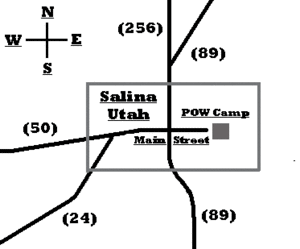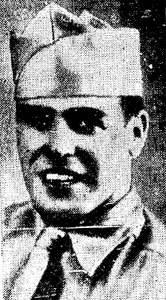Utah prisoner of war massacre
| Utah prisoner of war massacre | |
|---|---|
 | |
| Location | Salina, Utah, United States |
| Coordinates | 38°57′28″N 111°50′52″W / 38.95767°N 111.84777°WCoordinates: 38°57′28″N 111°50′52″W / 38.95767°N 111.84777°W |
| Date |
July 8, 1945 12:00 midnight (MST) |
| Target | German prisoners of war |
Attack type | Mass murder, POW massacre |
| Weapons | .30 caliber M1917 Browning machine gun |
| Deaths | 9 |
Non-fatal injuries | 20 |
| Perpetrator | Clarence V. Bertucci |
The Utah prisoner of war massacre (headlined by Time as Midnight Massacre[1][2]) occurred just after midnight on July 8, 1945, when an American soldier, Private Clarence V. Bertucci, killed nine German prisoners of war and wounded twenty others at a camp in Salina, Utah. It is remembered for being "the worst massacre at a POW camp in U.S. history", and the ensuing conviction of Bertucci made him one of only three American soldiers prosecuted during World War II for killing Axis prisoners. It was also notable for having occurred two months after the German surrender and the end of the war in Europe.[3][4]
Background
During World War II, Utah was home to some 15,000 Italian and German prisoners that were distributed across several camps. Camp Salina was a small, temporary branch camp that was occupied from 1944 to 1945 by about 250 Germans, most of whom were from Erwin Rommel's Afrikakorps. It was a simple complex; forty-three tents with wooden floors, an officer's quarters, and three guard towers around the perimeter. Unlike many other American prison camps, which were built in isolated areas, Camp Salina was located within the small town of Salina, at the eastern end of Main Street. The Germans had been sent there to help with the harvest, and, according to Pat Bagley of the Salt Lake Tribune, they were well-behaved and friendly to the locals.[5][6]
Private Bertucci was born in New Orleans in 1921. He dropped out of school in the sixth grade, and then joined the United States Army in 1940. After five years of service, including one tour to England with an artillery unit, Bertucci seemed to be incapable of being promoted and also had a "discipline problem". According to later testimony, he was unsatisfied with his tour and said that he felt "cheated" out of his chance to kill Germans. He was also quoted as saying, "Someday I will get my Germans; I will get my turn." Apart from overtly expressing his hatred of Germans, Bertucci did not show any indications of what he was planning on doing in the days before the massacre.[6][7]
Massacre

On the night of July 7, 1945, Private Bertucci was out drinking, although he stopped at a cafe on Main Street to have some coffee and speak with a waitress before reporting for guard duty back at the camp. After the midnight changing of the guard, Bertucci waited for the previous watch to go to bed, then he climbed up the guard tower nearest the officer's quarters, loaded the .30-caliber M1917 Browning machine gun that was mounted at the position, and then opened fire on the tents of sleeping Germans. Moving the gun back and forth, Bertucci hit thirty of the forty-three tents before being removed from the tower by another soldier. Bertucci was quoted to have said "Get more ammo! I'm not done yet!"[5][6][7]
The firing only lasted about fifteen seconds, long enough to fire 250 rounds of ammunition, and Bertucci is reported to have been taken into custody without any resistance. Six of the Germans were killed outright, three later died in Salina's hospital, and twenty others were wounded. One of the prisoners was "nearly cut in half" by the machine gun fire, although he managed to survive for six hours. It was said that "blood flowed out the front door" of the hospital.[5][6][7]
The Piqua Daily Call reported, "Clarence V Bertucci was under mental observation today [July 10] after admitting that he sprayed gun bullets on a group of war prisoners while they slept, killing eight and wounding 20 because he 'just didn't like Germans'."[8]
A July 23, 1945, article from Time stated,
Ninth Service Command officers admitted that Bertucci's record already showed two courts-martial, one in England. His own calm explanation seemed a little too simple: he had hated Germans, so he had killed Germans.[2]
Aftermath
The victims, who were between twenty-four and forty-eight years old, were buried with full military honors at Fort Douglas Cemetery. They were dressed in khaki American uniforms, but there were no flags on the caskets because the Nazi flag had been banned, and there was no new German flag available at that time. The wounded soldiers were sent back to Germany when they were deemed healthy enough for the journey. A statue called the German War Memorial has been placed at the cemetery. In 1988, the German Air Force funded the refurbishment of the statue. A ceremony was held on Volkstrauertag, the German national day of mourning, and two of the prisoners who were wounded in 1945 attended.[5][7][9]
Bertucci was found to be insane by the military, and hospitalized. He died in December 1969.[9] On November 12, 2016, a museum on the site of Camp Salina was opened to the public in Salina, Utah.[10]
See also
References
- ↑ Luce, Henry Robinson (1968). Time capsule/1945: a history of the year condensed from the pages of Time. Time-Life Books.
- 1 2 "Midnight Massacre – Time". Time. July 23, 1945. Retrieved December 6, 2012.
- ↑ "Salt Lake City Ghost Seekers: And the Plot Doth Thicken". Retrieved December 6, 2012.
- ↑ Carlson, Lewis H. (1998). We Were Each Other's Prisoners: An Oral History of World War II American and German Prisoners of War. Basic Books. ISBN 9780465091232.
- 1 2 3 4 "History Matters: Few know of World War II massacre in Salina". Retrieved December 6, 2012.
- 1 2 3 4 "American Soldiers and POW Killing in the European Theater of World War II". Retrieved December 6, 2012.
- 1 2 3 4 "The Utah POW Massacre – Providentia". Archived from the original on June 19, 2013. Retrieved December 6, 2012.
- ↑ "Piqua Daily Call, Tuesday, July 10, 1945 : Front Page : NewspaperARCHIVE.com". Retrieved December 6, 2012.
- 1 2 "Tragedy Finds Resting Place in Fort Douglas: The Daily Utah Chronicle". Archived from the original on July 20, 2013. Retrieved December 6, 2012.
- ↑ "Former Utah military camp where worst POW camp massacre on US soil occurred turned into museum | KSL.com". Retrieved 2016-11-14.